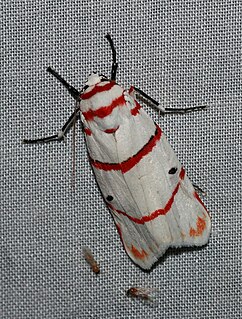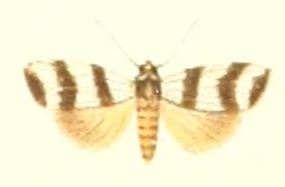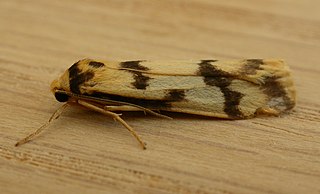
Spilomelinae is a very species-rich subfamily of the lepidopteran family Crambidae, the crambid snout moths. With 4,132 described species in 340 genera worldwide, it is the most speciose group among pyraloids.

Hypena is a genus of moths in the family Erebidae. It was first described by Franz von Paula Schrank in 1802. These non-migratory moths overwinter as pupae and almost never come to bait as adults.

Agylla is a genus of moths in the subfamily Arctiinae. The genus was erected by Francis Walker in 1854.

Barsine is a genus of moths in the family Erebidae.

Belemnia is a genus of moths in the subfamily Arctiinae. The genus was erected by Francis Walker in 1854. Species are found in Central and South America.

Cyana is a genus of moths in the family Erebidae. Species are well distributed in Africa, Madagascar, China, India, Sri Lanka, Myanmar, Sumatra, Java and Borneo. The genus was erected by Francis Walker in 1854.

Eutane is a genus of moths in the subfamily Arctiinae. The genus was erected by Francis Walker in 1854.

Halone is a genus of moths in the subfamily Arctiinae from southern Asia and Australia. The genus was erected by Francis Walker in 1854.
Heliosia is a genus of moths in the family Erebidae erected by George Hampson in 1900.
Macrosia is a genus of moths in the subfamily Arctiinae. The genus was erected by George Hampson in 1900.

Miltochrista is a genus of moths of the family Erebidae, subfamily Arctiinae. The genus was erected by Jacob Hübner in 1819.

Nepita is a monotypic moth genus in the subfamily Arctiinae described by Moore in 1860. Its only species, Nepita conferta, the footman moth, was first described by Francis Walker in 1854. It is found in India and Sri Lanka.

Nudaria is a genus of moths in the subfamily Arctiinae erected by Adrian Hardy Haworth in 1809.
Phaeophlebosia is a monotypic moth genus in the subfamily Arctiinae erected by George Hampson in 1900. Its single species, Phaeophlebosia furcifera, the forked footman, was first described by Francis Walker in 1854. It is found in Australia, where it has been recorded from New South Wales, Victoria, Tasmania and South Australia.
Siccia is a genus of moths in the family Erebidae. The genus was erected by Francis Walker in 1854.
Teulisna is a genus of moths in the family Erebidae. The genus was erected by Francis Walker in 1862. They are found in Sri Lanka, India, Myanmar, Borneo and Java.

Tigrioides is a genus of moths in the family Erebidae. The genus was erected by Arthur Gardiner Butler in 1877.

Phryganodes is a genus of moths of the family Crambidae described by Achille Guenée in 1854.
Castulo plagiata, the yellow-banded footman, is a moth of the subfamily Arctiinae. The species was first described by Francis Walker in 1854. It is found in the Australian states of New South Wales, Victoria and Tasmania.

Ilemodes heterogyna, the broad buttered footman, is a moth of the family Erebidae. The species was first described by George Hampson in 1900. It is found in Malawi, South Africa, Uganda, Ethiopia and Kenya.













